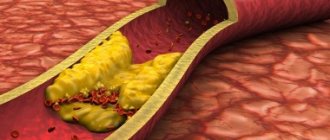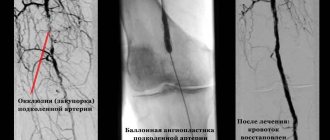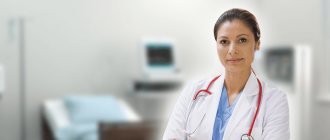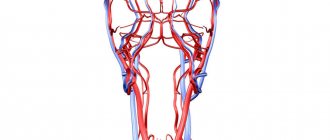Among all diseases of the vascular system atherosclerosis of the lower extremities considered one of the leading causes of disability as well as mortality worldwide. According to statistics, every fifth man over 65 years old suffers from atherosclerosis of the lower extremities. A dangerous complication of this disease is the development of gangrene and often amputation of the limb.
With atherosclerosis of the lower extremities, the arteries are affected and trophic changes develop in the tissues of the legs. Typically, blood circulation in the legs is disrupted in the popliteal, tibial and femoral arteries.
In 70% of cases, the disease occurs with obliterating syndrome, when partial or complete restriction of blood flow occurs against the background of a gradual narrowing of the lumen of the conducting vessels.
1 Swelling of the legs
2 Atherosclerosis of the lower extremities
3 Varicose veins
Chronic obliterating atherosclerosis of the lower extremities is associated with impaired blood circulation in peripheral vessels and the occurrence of changes in tissue trophism. With obliterating atherosclerosis of the vessels of the lower extremities, excess cholesterol ingested with food spreads through the bloodstream, reaches the walls of arterial vessels, accumulates there and forms cholesterol plaques. Cholesterol plaques grow and make the lumen of blood vessels narrow.
If atherosclerosis of the lower extremities is not treated, complete blockage of the veins occurs, swelling occurs and gangrene may begin.
Types of atherosclerosis of the lower extremities
Chronic obliterating diseases of the arteries of the lower extremities (COLD) are a whole group of blood vessel diseases in which blood flow through the arteries is greatly reduced due to their narrowing (stenosis) or complete blockage (occlusion).
In KHOZANKA there are three main types of diseases:
- obliterating atherosclerosis (develops in old age);
- obliterating endarteritis (thrombangitis, nonspecific inflammation of the vascular wall, occurs more often at a young age);
- peripheral forms of nonspecific aortoarteritis.
The most common of these diseases is considered to be obliterating atherosclerosis.
Possible risks associated with atherosclerosis
The most dangerous complication is a stroke. If at the same time the patient has poor eating habits, is overweight, moves little and is regularly exposed to stress, then with an 80% probability he will become disabled as a result, unable to care for himself. The mortality rate is also high.
Prevention
To prevent cerebral atherosclerosis, you need to avoid smoking, follow a diet, and keep yourself in good shape with moderate physical activity. It is very important to establish a psycho-emotional background, protect yourself from stress, and if this is not possible, then take courses of sedatives and amino acids, for example Glycine.
| Name of service (price list incomplete) | Price, rub.) | In installments* |
| Appointment (examination, consultation) with a cardiovascular surgeon, primary, therapeutic and diagnostic, outpatient | 1 750 | — |
| Program “Risk of atherosclerosis and ischemic heart disease, predisposition to dyslipidemia” | 19 000 | — |
* You can read more about the conditions here - Treatment on credit or in installments.
How does the disease manifest itself?
With atherosclerosis of the extremities, a person begins to experience sharp pain when walking and lameness appears. After walking short distances, the patient feels terrible fatigue, stiffness in movements, cramps, and his toes go numb. It seems that the leg suddenly became unbearably heavy, as if a weight had been put on it. Typically, one leg is affected by atherosclerosis of the lower extremities. After rest, the pain goes away, but not for long.
Cause of numbness in legs
Probably each of us remembers this unpleasant feeling when our legs go numb and you simply can’t feel them. This includes tingling throughout the body, a “chill,” and a feeling of temporary paralysis of the limbs. There are different reasons for this:
- uncomfortable sitting position, when nerve endings are compressed;
- diabetes mellitus;
- poor circulation in the legs,
- manifestation of osteochondrosis;
- lack of vitamins in the body;
- migraine;
- multiple sclerosis;
- inflammation of the nerves in various diseases: arthritis, etc.
Fortunately, numbness in the legs is not always a harbinger of serious illness. However, this is always a reason to immediately contact a vascular surgeon.
Risk factors for the development of atherosclerosis of the lower extremities:
- age 40 -50 years;
- male gender;
- large amounts of alcohol;
- smoking;
- high cholesterol levels;
- diabetes mellitus;
- hypertension;
- stress;
- sedentary and sedentary lifestyle.
Surgical techniques
Surgery is a last resort and is usually prescribed for severe ischemia and very severe complications. Nowadays, different types of surgical interventions are performed. Some involve a day hospital, some require a long-term hospital stay under observation. Patient rehabilitation plans and post-operative care vary. Our doctors advise patients in detail on all aspects related to surgical intervention and carefully monitor their health in the pre- and postoperative period.
Surgical treatment of atherosclerosis of the lower extremities:
- bypass surgery - an additional “bypass” path for blood flow is created around the area of narrowing of the artery;
- stenting - a special tubular spacer is placed in the affected vessel, which ensures the required diameter of the artery;
- balloon angioplasty - similar to stenting, only a balloon is inserted into the vessel cavity rather than a spacer, which expands its lumen;
- autodermoplasty - if trophic ulcers are poorly treated conservatively, they are operated on and covered with the patient’s own skin;
- endarterectomy - removal of the affected part of the artery in which the atherosclerotic plaque is located;
- prosthetics – replacement of the affected vessel with the patient’s own vein, taken from another place, or with a synthetic prosthesis;
- amputation - prescribed in severe cases when gangrene occurs, after which prosthetics are performed.
In 75-85% of cases, after surgery, blood circulation is completely restored for an average of 5-8 years.
Indications for surgery:
- an aneurysm that may rupture;
- chronic ischemia of critical stage;
- hemodynamically significant carotid artery stenosis or plaque accompanied by symptoms of cerebral ischemia;
- decompensation of blood circulation in the leg due to embolism, trauma, thrombosis.
Contraindications to surgical treatment:
- wet gangrene with sepsis;
- severe disruption of vital organs - renal and liver failure, circulatory disorders in the brain, myocardial infarction, heart failure, etc.
Classification of stages of arterial insufficiency of the lower extremities
- Stage 1 (a person is able to walk freely for about a kilometer);
- Stage 2 (the patient is able to walk about 200 meters without pain);
- Stage 3 (a person can move less than 50 meters, he begins to be very bothered by “pain at rest”, in which even during a night’s rest the patient feels the need to lower his foot to the floor several times a night);
- Stage 4 (necrotic changes develop in the toes).
At the last stage of the disease, amputation is possible.
Symptoms of atherosclerosis of the lower extremities:
- lameness;
- rapid fatigue when walking;
- pain when walking in the calf muscles and thigh muscles;
- feeling of muscle contraction;
- numbness in the legs and a constant feeling of coldness in the extremities;
- in the stage of exacerbation of the disease, the color of the skin on the affected leg may change, it will become a pale bluish tint.
A more severe stage of the disease is characterized by the following symptoms:
- increasing lameness;
- legs constantly go numb;
- the pulse cannot be felt during palpation in the popliteal fossa, on the ankle and thigh;
- pain not only when walking, but also at rest;
- insomnia at night due to pain and numbness in the legs;
- cyanosis of the skin, the skin becomes brownish-red in color, hair falls out on the skin of the legs, nails peel, ulcers appear on the heel and toes.
Chronic arterial insufficiency of the lower extremities affects 2-3% of the population, while obliterating atherosclerosis of the arteries accounts for 80-90%. Unfortunately, at present KHOZANK has become much younger. If previously older men suffered from these diseases, now they affect even young men and girls. There is a high risk of developing diseases in this group in smokers. When smoking 20 cigarettes a day, the risk of developing COPD increases 4-6 times. Every year, tens of thousands of people die as a result of obliterating atherosclerosis of the vessels of the legs.
Is it possible to stop and treat atherosclerosis?
The first reaction of patients to a doctor’s phrase about existing abnormalities in cholesterol levels and atherosclerosis is the use of all kinds of folk methods with the aim of “cleansing blood vessels of cholesterol.” Contrary to popular belief, blood vessels cannot be freed from atherosclerotic plaques once and for all. Atherosclerosis is a manifestation of internal and serious disorders in the functioning of the body; prevention of further development is possible only with the use of a complex of various medical techniques. Although, of course, the patient himself can do a lot: think through his diet, include adequate physical activity in his daily routine, and also follow the doctor’s recommendations on the use of medications (statins, hepatoprotectors and other medications can be prescribed for this purpose).
The role of massage in the treatment and prevention of atherosclerosis
Medical massage if a patient has atherosclerotic changes in blood vessels is a mild form of physical exercise and is very useful. It is used both during spa treatment and as an auxiliary physiotherapeutic technique for a wide range of patients. However, it is worth considering contraindications and the patient’s condition (assessed by a doctor).
The main purpose of massage for atherosclerosis is passive stress on the muscles and improvement of blood circulation in a certain area of the body. Massage has a pronounced preventive effect, as there is an increase in blood supply to vital organs - the heart, brain (as well as the lower extremities), which, together with other lines of treatment, leads to a significant improvement in overall well-being and body parameters.
25% of the massage session time should consist of planar and volumetric stroking to improve blood flow; 20% - rubbing, which results in dilation of blood vessels in a certain area (rubbing with the edge of the palm / bent fingers or gentle shallow percussive movements); 35% is occupied by kneading, which provides the effect of physical activity, horizontal and vertical kneading - two main techniques that should be used primarily on the limbs; finally, 20% of the massage session time is occupied by continuous vibration.
The massage technique differs depending on the patient's condition. For example, during treatment in a hospital, massage is done in a lying position, starting with the lower extremities (shallow stroking, rubbing with fingertips, longitudinal felting). Then they move on to a back massage.
In an outpatient setting (the patient’s condition is satisfactory, he comes to the clinic for a massage), the massage session begins, on the contrary, from the back area (movements from bottom to top, from the lumbar to the cervical region), then the effect is applied to large muscle groups in the back area, the collar area. The procedure is completed with a massage of the anterior chest wall with an emphasis on the left half (pectoralis major muscle, shoulder).
A gentle massage option for weakened patients with vascular atherosclerosis is to influence the muscles and skin of the head and shoulder girdle. The massage lasts 5 - 20 minutes and is carried out daily for 10 days.
When massaging the head (it is massaged first), you need to influence the frontal, temporal region and scalp, carefully using stroking, vibration, rubbing and kneading techniques. Kneading looks like moving the scalp in different directions and applying light pressure. The duration of the head massage should not exceed 5 minutes.
When massaging the collar area, stroking, light rubbing, kneading and continuous vibration are used according to the standard method of European massage.
Neck massage should be limited to a gentle effect on its back surface.
The time of exposure to the collar area is about 10 minutes. The first 3 sessions should be carried out carefully observing the patient's reaction.
An important advantage of performing a massage for atherosclerosis will be the extensive experience of the specialist performing the procedure. It is worth noting that therapeutic massage in this case is not a general strengthening event, but a full-fledged effect on the body and the cardiovascular system in particular, necessary to prevent the development of the disease.
Additional articles with useful information
The impact of massage techniques on different human systems (cardiovascular, lymphatic, muscular, etc.)
The human body gratefully accepts the massage procedure, as it facilitates the functioning of most human systems and can act as an additional method of treatment for many diseases of the internal organs. Read more…
Massage that activates the lymphatic system
Life around us has recently become very active, but many processes inside the body, on the contrary, have slowed down. One of these processes is the circulation of lymphatic fluid, which is possible only with the contraction of skeletal muscles. Read more…
| Share with friends and colleagues |
Diagnosis of atherosclerosis of the extremities
To make a correct diagnosis and find out whether you have atherosclerosis of the lower extremities, you need to undergo a full examination. This will help to identify the degree of vascular patency and blood supply to the legs, determine the level of occlusion and the extent of vascular pathology in atherosclerosis.
1 Determination of pulsation of arteries of the extremities
2 Determination of pulsation of arteries of the extremities
3 Determination of pulsation of arteries of the extremities
To do this you need:
- get advice from a vascular surgeon;
- measure blood pressure in the arms and legs;
- determine the pulsation of the arteries of the limbs;
- undergo MCT angiography;
- undergo duplex scanning of peripheral arteries.
1 Consultation with a vascular surgeon in MedicCity
2 Ultrasound of arteries in MedicCity
3 Ultrasound of arteries in MedicCity
Causes of the disease
The cause of the development of this vascular disease of the retina may be:
- atherosclerosis (every third disease of the choroid occurs for this reason);
- hypertension (every fourth disease);
- rheumatism;
- temporal arteritis;
- neurocirculatory dystonia, arrhythmia.
If treatment for this disease is not started promptly, complete loss of vision is possible.
1 Diagnosis and treatment of vascular diseases of the retina
2 Diagnosis and treatment of vascular diseases of the retina
3 Diagnosis and treatment of vascular diseases of the retina
Treatment
Unfortunately, it is not yet possible to completely cure atherosclerosis, but it can be stopped and thereby alleviate the patient’s condition. With the help of treatment, it is possible to reduce pain in the affected area of the limb, increase comfort when walking over certain distances, prevent the risk of complete blockage of the veins and prevent the development of gangrene, as well as stroke and heart attack. Therefore, treatment must be constant, comprehensive and continuous.
Great importance is attached to the prevention of the disease, so it is important to move more, lead a healthy lifestyle, stop smoking and drinking alcohol. With the development of atherosclerosis of the lower extremities, it is important to choose the right diet by removing foods with high cholesterol content from your diet and adding foods containing polyunsaturated fats.
Remember, if your arms and legs are numb, this may be a symptom of incipient problems with blood vessels. Therefore, if you already feel numbness in your legs and pain when walking, seek help from a specialist! In the multidisciplinary clinic "MedicCity" you can receive treatment from highly professional vascular surgeons who use the most modern techniques.
Treatment of cerebral atherosclerosis
It is not only the neurologist who treats patients with atherosclerosis in our center. We treat the disease comprehensively with the involvement of doctors from different specialties. This approach makes the recovery process comfortable, gives better results and helps patients return to their normal lives sooner.
The basis for the treatment of cerebral atherosclerosis is the correct selection of nutrition. On the one hand, the diet combines a complete diet with individually designed physical activity. On the other hand, medications help compensate for the pathological process and reduce the harmful effects of the disease on the body.
Medicines used:
- diuretics;
- drugs that normalize lipid and blood sugar levels;
- vitamins;
- drugs to improve cerebral circulation;
- means for normalizing blood pressure and heart rate;
- thrombolytic agents, etc.










